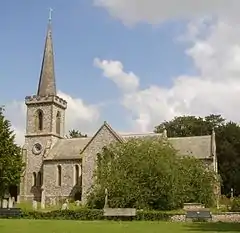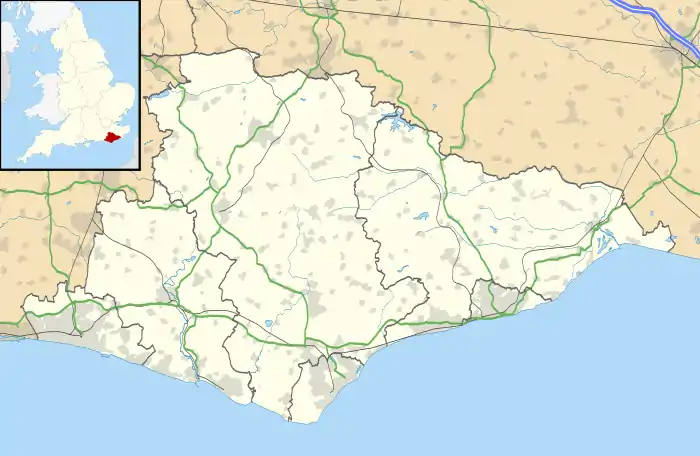Stanmer
Stanmer is a small village on the eastern outskirts of Brighton, in East Sussex, England.
| Stanmer | |
|---|---|
 Stanmer Church | |
 Stanmer Location within East Sussex | |
| OS grid reference | TQ335095 |
| Unitary authority | |
| Ceremonial county | |
| Region | |
| Country | England |
| Sovereign state | United Kingdom |
| Post town | BRIGHTON |
| Postcode district | BN1 |
| Dialling code | 01273 |
| Police | Sussex |
| Fire | East Sussex |
| Ambulance | South East Coast |
| UK Parliament | |
History
The etymological root of the name is "Stony Mere", Old English for "stone pond", referring to the sarsen stones around Stanmer village pond. The stones are not in their original situation, but have been gathered from the Downs and landscaped into the park's appearance. There have been rather inconclusive archaeological excavations at Pudding Bag Wood and Rocky Clump in the north of the park, and in Stanmer Great Wood, producing evidence of occupation from Neolithic times onwards.
The village is first recorded in about 765 A.D. when (if the document is authentic) land there was granted by king Ealdwulf of Sussex to Hunlaf in order that he might found a college of secular canons at South Malling near Lewes. In the Middle Ages it had the curious distinction of forming a detached part of the Rape of Pevensey, which is otherwise east of the Ouse.
Landmarks
It was for long a closed village ruled by the resident lords of Stanmer, with a population static at just over 100. From the eighteenth century onwards the lords were the Pelham family who received the title Earl of Chichester in 1801 in addition to the Baron Pelham of Stanmer they had had since from 1762. They lived in the mansion called Stanmer House, built in its present Palladian form in 1722, a Grade I listed building. It stands at the centre of Stanmer Park, landscaped by Humphry Repton, which was awarded Grade II "park of special historic interest" status by English Heritage in 1983. In the eastern portion of the park was built, from 1960 onwards, the University of Sussex.
Stanmer Church, with a narrow spire unusual in Sussex downland, is adjacent to the pond and to Stanmer House. Its historic dedication is unknown. It was built in 1838 on the site of a 14th-century predecessor destroyed by fire.
Stanmer has a working farm at its centre. Near the church is an unusual survival, a donkey wheel, i.e. a treadmill formerly operated by a donkey. There are 18th-century lodge-houses at the upper and lower ends of the park. The village also possesses former almshouses in the Chichester name, built around 1900.
The Stanmer Preservation Society has been responsible, over the years, for the maintenance and upkeep of many of the agricultural artifacts which were discovered and excavated in the Stanmer Park locality. Included in with some of these include those from Rocky Clump, first discovered by Walter Gorton and Charlie Yeates in the 1950s. It also now maintains the church, Rural Museum and Donkey Wheel.
Stanmer and Brighton
The village was incorporated into Brighton in 1928, and the park passed into the hands of the county borough council in 1947. The park is now a major public space for the residents of the city of Brighton and Hove, and regularly hosts such events as kite-flying and combined driving (horse-driving trials). Stanmer House was used as offices by the university in the 1960s and 70s, but was recently derelict and in need of restoration. It is now partly open to the public again and is licensed as a wedding venue.
Sources
- Berry, Sue (2005) Stanmer House and Park, East Sussex : the evolution of a small downland country house and its setting c.1710-1805. Sussex Archaeological Collections 143, 239-55.
- Brighton Archaeological Society (2000) Field Unit Archive 2000, http://www.brightonarch.org.uk/13_1.htm (scroll down).
- Carder, Tim (1990) Encyclopaedia of Brighton. Lewes: East Sussex County Libraries.
- Funnell, John (2000) Excavations at Rocky Clump, Stanmer. Flint 43.
- Gorton, W.C.L. & Yeates, C.W. (1988) Rocky Clump, Stanmer: a forgotten shrine? Stanmer Preservation Society.
- Warne, Heather (1989) Stanmer: a restructured settlement. Sussex Archaeological Collections 127, 189-210. [Deals with the period 1600-1700.]
- Yeates, C.W. and others (?1980s) Stanmer, 2nd edn. [Ditchling]: Stanmer Preservation Society.
- Yeates, C.W. (1986) Hovel in the wood. Privately published. [Partly reminiscence, partly archaeology.]
An important documentary source, the estate accounts from 1769–1950, is housed in East Sussex Record Office, Lewes.
See also
External links
| Wikimedia Commons has media related to Stanmer. |
